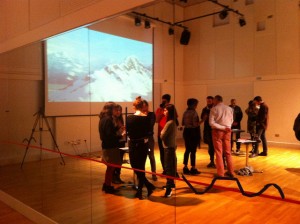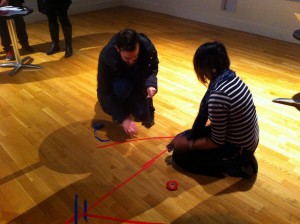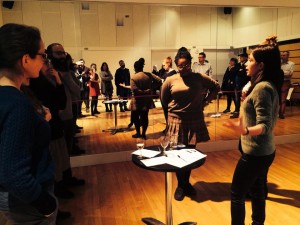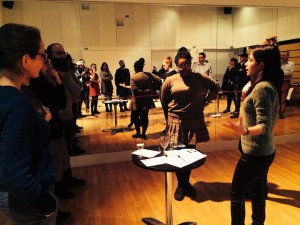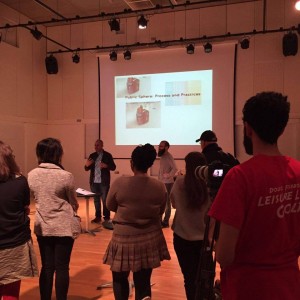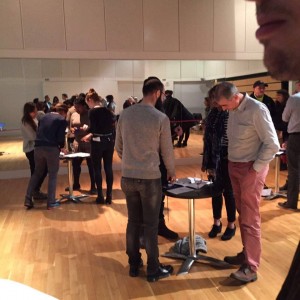
CREACTION Roma. La Cultura che Crea
12 Aprile 2016
ECOISMI 2016
20 Aprile 2016PUBLIC SPHERE: PROCESS AND PRACTICES | Once you’re on the ground…
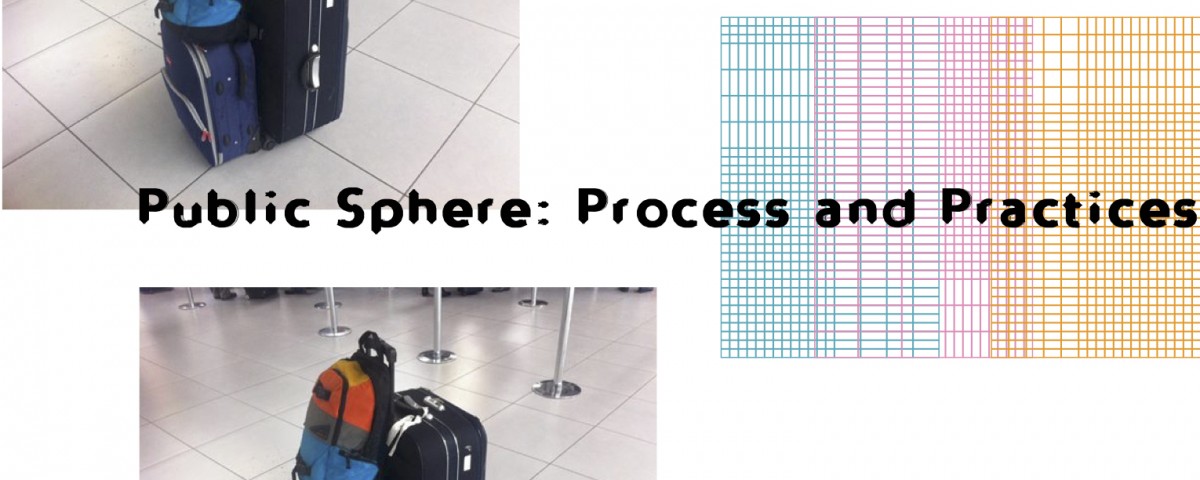
We usually workout to react to the status-quo and feel better. We usually workout to differently perform our position in the world trying to discover how to react to different situations. Sometimes we already know it, sometimes we need to improvise. We don’t know the answer yet, and maybe there is no answer at all or, at least, multiple different answers. Once we’re on the ground we have to unlearn in order to learn again; forget our language in order to re-negotiate it trying to build up a different imaginary in discontinuity with the previous ones.
Every time we go on the ground we re-start by differently performing our position. According to its characteristic to be nor stable, neither fix, the language react on the places we walk through, on the environment and on the people we met. The result is totally unpredictable and grows up organically with our journey.
Moreover, the public sphere and its relationship with the Art, the macro-topic this project focuses on, cannot be still considered as one entity, as one location, but as a fragmented place «consisting of a number of spaces and/or formations that sometimes connect, sometime close-off and that are in conflictual and contradictory relation to each other» (S.Sheik). This makes the things even more unpredictable.
Hence, the public can be considered as a platform of subjectivities, of politics, and different economies. An arena. A battleground (P.Bourdieau; H. Haake) and the Art field is only one of these spaces, with its own language, its own identity, interconnected with the others and absolutely not independent. Even more if we consider the interdisciplinary approach that many of the practices have nurtured at least in the last twenty years: expanded practices that interact with different fields (architecture, urban planning, sociology, philosophy etc.). «The field of art has become a field of possibilities, of exchange and comparative analysis» (S.Sheik). A field able to connect with other fields. Again: a vector able to create a new language based on any pre-determined forms or thoughts. Able to set up a new imaginary and a new symbology.
Given this as a brief preface, the places I survey in Nottingham – starting from the New Art Exchange, the institution that hosted my project, passing through the other spaces, mainly considered independent but to some extent real institution (One Thoresby Street, Backlit and Primary) – as well as the artists I talked with or the projects I experienced, on different degree and portion respond all to the need to open a dialectical tension with the territory and the local communities, whatever the community is, on the basis of visual art projects. This is the case of The Hyson Green Workshops, a project by the designer Bahbak Hashemi-Nezhad, which explores an ambitious citizen-led project that emerged in NAE’s local neighbourhood, Hyson Green, in the 1970s. «Faced with ill-considered planning and architectural flaws of mass social housing, the active citizens of the flats, spearheaded by the Hyson Green Development Tenants’ Association, reacted by co-designing alternative solutions in their environment. Together, the group fought to transform the disused and problematic garages, situated underneath the flats, into spaces for cultural expression, community activity, and economic growth». But is also the case of Doug Fishbone’s Leisure Land Golf, the project is now running at NAE, designed and made by ten artists. «The installation uses the fun and accessible game of mini-golf as a powerful tool for questioning the leisure industry and society’s compulsion for consumption whilst also addressing other important cultural topics from migration to global warming and globalisation».

Small Food Bakery, Primary, Nottingham
This is as well the case of the Small Food Bakery at Primary, a place that instigates the doubt on its nature: an art project, a social convivial place or simply a bakery? A project in its initial phase which aims to create a sense of familiarity imagining a different way to produce and consume, to create an economy and, on long-term, to affect the local diet on the base of a different ethical choice. A bakery in an art venue that definitely contributes to blur the boundaries facilitating the access to people that not necessarily works into the art field. Primary itself is thus a porous place which engaged with the territory and the local communities (artists or people from the neighbourhood) on different levels starting for example from a public program – Interaction – based on crossover’s practices. The program aims to encourage processual practices like workshops which goal is to nurture the dialogue among people that are not used to sit on the same table. A project that invests in the relationship by sharing knowledge and skills. A project that undermines the self-referential art language to go towards the concrete needs that come from the local communities.
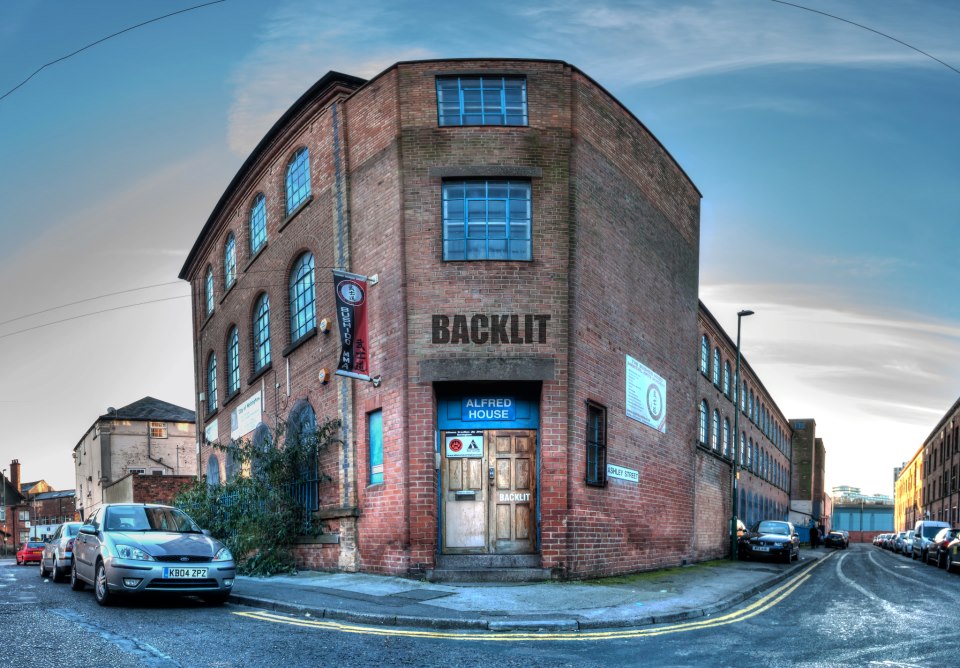
Courtesy Backlit
Nevertheless in the specific case of Backlit, the engagement with the local area is determined by the Samuel Morley’s legacy (Morley Program). Samuel Morely is, in fact, a crucial character in the local history – a sort of forgotten hero – mainly described as a philanthropist, Member of Parliament, social reformer and ardent abolitionist with a radical approach to the social activism and human rights. The activities fostered by Backlit – exhibitions, critical sessions, production and commission of artworks, workshops, lectures i.e – are hence the keys to explore, re-read and re-interpret the story of the building becoming so a resource to reconnect the community and the territory with the place itself. The result of a work drove in this direction, definitely contribute to creating a mutual identification between the local people and the building itself making this become a sort of monument. A symbol, potentially.
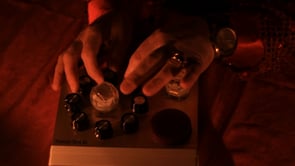
Between the Devil and the Deep Blue Sea, Video frame, 5’31”, Courtesy the artist and Backlit
As mention above, the Morley Program also determines, in terms of visual art and in some cases, the commission of an artwork. Is the case of Between the Devil and the Deep Blue Sea a video by Tracey McMaster. The video formally revisited the Samuel Morely’s figure in the spirit of Twin Peaks, the cult series of the Nineties. The title refers to a line said by the main character of the film. Here, in a minimal but at the same time deliberately campy environment, a real psychic, talk about Samuel Morley revisiting his personality, his desires, his ambitions without any script at the basis. Formally built on the basis of the opposition between fiction and reality, the movie was shot in real time. It doesn’t matter if what the psychic says is true or not, what actually really matter is that he believed in what he was saying which also make the spectator believe in it.
So, once you’re on the ground, once you start confronting with people, sharing with them time, thoughts and knowledge what it supposed to be in your mind slightly shifted in something different. Franco Purini, one of the most important Italian architect, once said: «The drawing is the conceptual place of reconciliation between the perfect space of the invention, represented in its ideal landscape, and the autonomy of the object produced into a non-comparable reality with any prefiguration». That means the draw is a sort of critical tool able not only to imagine a project but also the atmosphere in which we want it to be absorbed and perceived. Imagine a project has a strong power in terms of creativity, which has to be preserved in some ways, but, on the other hand, this is clearly ideal. Once you’re on the ground you start to face the reality re-negotiating your practice as a curator in the first place. It starts to be less ideal and your language immediately begins to react to the environment as a sort of chameleon. It is not only about the content but also about you narrate it.
In the specific case of this project, as soon as I started to open the dialogue with the New Art Exchange sharing with them my intention to make a wider, open and inclusive process involving people that were not necessarily part of the art world, they invited me to consider the possibility to re-think the title. So, what it supposed to be presented with the same title – Practices as an Intersection in a Fragile Environment – changed in Public Sphere: Process and Practices as the result of a dialectical process between me and the New Art Exchange. The title is not a tiny insignificant detail but, indeed, a critical point. The starting point of the project itself. A point that pushed me in the condition to re-imagine and re-shape the project in a different way.
So, if the project can count in its long trajectory on the same shared-methodology, what definitely changes is the attitude which necessarily has to respond to what the territory asks to be narrated. This actually makes the difference between each chapter of what I conceived as a long-term narration. This also makes the difference between Nottingham and the two previous chapters/episodes that took place in Milan (2014) and New York (2015).
The title, as a trigger, determined the narration and, what at the beginning was supposed to be presented as a traditional panel discussion slightly shifted into a game. A game concerning three of the most important and crucial keywords I crossed my path with during my dialogues in this two months of permanence in Nottingham. Long term vs short term; language; sharing.
What is actually interesting, and to some extent even paradoxical, is the fact that a project, which is basically based on a process, ends up with another process which aims to instigate a different perspective and challenge the status-quo by setting up a sort of performative vocabulary based on three words.

Untouched By Man, Installation of objects with royalty free HD stock footage, 2015, Courtesy Connor Brazier
As mentioned at the beginning of the text, the entire project has been based on a sort of long workout finalized in the performing room of the New Art Exchange. Metaphorically speaking a sort of gym where people who attended the game could respond to the exercises proposed experimenting the language in its totality by writing, drawing or performing each question. They could use the space of the performing room as well as the space of the grid printed on the paper, a metaphor of the public sphere, a field of action, drawn by the Italian graphic designer, Roberto Memoli, as a result of a long conversation between me and him on the project. They could even experience the atmosphere being provoked by three video projections made by the local artist Connor Brazier as, again, the result of a one to one studio visit/workshop. Connor, who produced the video with his peer Jade Williams, visually reacted to my instigations giving his interpretation of the three words. His practice as an artist eventually focuses on the spaces in between: the hybrid spaces. Being originally half Polish half English; being an artist and curator (he runs the program of Hutt collective), pushes him to constantly re-negotiate his position as an outsider questioning what as an artist nurture his role as a curator and vice-versa. As an artist, his practice definitely explores the conceptual potentiality behind the objects as a trigger of different meanings in different places. The wrong places, the hybrid spaces, where object, images and sounds already existing claim for an open meaning.
The New Art Exchange – that shared with the BJCEM the risk to support a discursive project – in its public role, definitely fostered a performative project that aims, in the Nottingham’s chapter, to be a bridge across different disciplines slightly touching fields that go beyond the art field. An expanded practice that tried to connect unexplored dots, and people, around the city. A project that aims to share tools, thoughts, and knowledge and write its (self)narration in a trajectory that contributes to creating different signs, a different imaginary, a thought that could be unproductive instead of profitable and productive (S. Sheik).
Claudio Zecchi
More info about the project PUBLIC SPHERE: PROCESS AND PRACTICES Practices as an Intersection
in a Fragile Environment #3_Nottingham can be found here:
http://www.bjcem.org/projects/current-projects/practices/
http://performativepractices.blogspot.co.uk/p/public-sphere-process-and-practices.html
